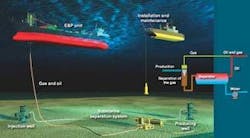Subsea separation, reinjection system solves problem of produced water
Peter Howard Wertheim, Dayse Abrantes - Special Correspondents
Petrobras’ research and development center, Cenpes, is working with subsea water separation systems to reinject produced water.
“The system is being designed to operate in 2008 at water depths ranging from 800-1,500 m, at the Marlim field in the Campos basin. Its main features include a modular configuration, small size, and reduced weight in order to allow handling by a wider range of installation vessels,” said Mauro Euphemio, an equipment engineer at Cenpes.
By the end of 2005, Petrobras had conducted three different design projects with Kvaerner, Vetco, and FMC. The Kvaerner and FMC projects are in their final stages, under technical evaluation. Vetco decided to leave the project.
The development of a subsea separator that withstands high water pressure depths and separates water from heavy oil would address a number of challenges, including issues facing mature fields such as Marlim.
The platforms operating in these areas were designed to process some liquids. They also have a limited capacity for water treatment. Because mature fields tend to produce more water, the wells with greater water production have to be shut in.
Scheduled field test
The primary challenges for water separation systems include the highly stable emulsion generated on the water and heavy oil stream, coupled with lower temperatures found subsea.
For the Marlim field tests, the system will be installed at 872 m and as close as possible to the wellhead to minimize heat loss in the flowline.
One benefit expected with the pilot installation, besides testing technology for a broader application on Marlim, is a reduced load on the process plant at the host facility, providing room for additional wells, said Euphemio.
The project is being developed under the PROCAP-3000 program (deep water E&P technology for 3,000 m). The first phase, carried out in 2005, consisted of technical and economical evaluations, resulting in the addition of production-injection wells on the Marlim field. The second and third phases, which are being developed together, comprise a series of lab and field tests on the basic subsea system design. These phases consist of implementing a prototype on the chosen development scenario for a real scale lab application which is expected to come on stream in early 2009 with theP-35 platform.
The Marlim 102-H, which is connected to the floating production unit, discharges liquids at a rate of around 17,000 b/d, with 55% water. The separator is being designed to process 19,000 b/d of fluid.
“There is a need to develop and qualify more compact and efficient separators for subsea application aiming to substitute the huge traditional systems based on gravity separators,” said Roberto Carlos Gonçalves de Oliveira, D.Sc., process technology and petroleum evaluation manager at Petrobras, “For deepwater processing, it is essential to use robust and efficient equipment. That equipment should also be compact and nearly maintenance-free.”
A compromise needs to be reached between compactness and efficiency. While in pursuit of processing subsea compactness, the Petrobras R&D team studied several alternatives. Because it found compact separation systems too sensitive to feed fluctuations (slugs, for instance), Petrobras is trying to develop and to improve intelligent control systems to minimize any deterioration in performance.
The company’s experience shows that reducing the shear imposed when flow passes through valves and pumps, for instance, improves the separation process. Lab tests prove that adding demulsifier through the gas-lift injection line can optimize the system’s performance as well. Both recommendations were considered in designing the subsea processing system, said Oliveira.
Extensive modeling and experimental work was performed using static and dynamic simulations to develop mathematical models for the new process. Coupling simulations of multiphase flow with the dynamic models of separation equipment lead to the determination of possible barriers to optimal system performance.
Research has been conducted to help characterize the type of oil/water dispersion that exists in the subsea equipment, including the presence of foam and solids. Oil-in-water meters are under development, which will be crucial for controlling the subsea separation process as the oil-in-water concentration in the reinjected water is the main controlling parameter.
“It became clear that subsea processing is much more than just installing separation facilities on the seabed. There are many issues that need to be addressed in advance for the system to reach its desired performance,” said the Petrobras official.

